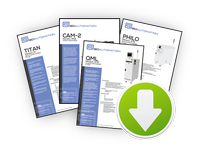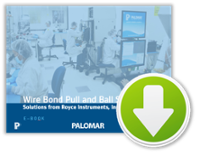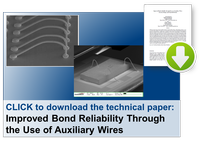In terms of first-level interconnects, what is the absolute best possible condition? The answer would be mid-span wire breaks during destructive wire pull testing. Of course, this is nearly impossible 100% of the time, but what if there was a technology that could provide these interconnects about 95% of the time? What of the other 5%? Palomar has a bonder with these capabilities: the 8000i Wire Bonder/Ball Bonder.
 |
 |
 |
Model 8000i in three options: Stand-alone, Fully Automated Inline (small island), and Ergonomic
Mid-Span Breaks
There is nothing easy about the goal of achieving mid-span wire breaks. It is not so much a direct challenge to the wire bonder, but it is for the materials supplied to the bonder. It would matter less if the materials were of less-than-perfect condition, but consistent. The reality is that some materials presented to the wire bonder are perfect or near perfect, allowing for high quality wire bonds. The more persistent problem becomes variation.
With organic contaminations, we can plasma clean them away and provide a repeatable contamination circumstance. If we have binder or fritz issues, these will come and go meaning some packages will be in great bonding condition, while others may not. These variations and many more are the most difficult for any wire bonder to deal with.
If there is poor metallization but it is repeatable, we can optimize our way into a workable position. The problem is that this is rarely, if ever, the case. Material variation can cause uncontrollable situations. So what can be done to resolve this issue?
The easiest part of a ball bonded wire is the first bond (“ball bond”) versus the second bond (“stitch bond”). The ball bond is big, thick, pliable, deformable, and controllable–much more so than the stitch bond which is very thin and uses only part of the ceramic capillary. So in terms of Cpk (process capability) the first bond, the “ball bond”, is much more forgiving of less-than-perfect materials and material variation.
Security Bonding
What is needed is a ball bonded wire with a ball at both ends, which used to be called a security bond. The ball bonded wire is placed and a separate ball bump is placed on top of the stitch, forcing a high reliability interconnect. The problem here is that in some cases there is variation in the hardness of the material that is being bonded. This can be due to the way the metal is applied, be it thick or thin film, plated metal, etc. which is in general typically high purity gold.
If the package has hard or thin gold in some areas, we have to over-bond (over-deform) the stitch to make sure that it does in fact stick when we break the wire to form the next ball. This is called a “lifted stitch”. It almost always leads to rework, which could require removing the die or device. The concept of security bonding always comes at a cost and some rework is almost inevitable.
 Security bonds (on left)
Security bonds (on left)
Stand-off Stitch Bonding
The 8000i Wire Bonder/Ball (Stud) Bumper has the ability to generate a wide variety of ball bump shapes and sizes at the same time that it generates normal ball bonded wires (ball/stitch wires). This combination occurs with standard capillaries and standard selenium-doped wire bond wire, with standard elongations. It takes a special wire bonder to be able to accomplish this without using a specialty wire (like palladium-doped wire) or a special ball bumping capillary.
Since the 8000i can achieve these combinations, it only makes sense to advance high reliability wire bonding to new levels. By placing a near flat-topped ball bump where the stitch is going to be bonded, then forward bonding a normal wire on to it, we can generate first-level interconnects that exceed all military standards in terms of destructive testing.
 Conventional |
 With a Running Chain |
 Stitch-Stitch |
The other 5%
The vast majority of the other 5% of interconnects are in the HAZ area (Heat Affected Zone) above the ball. The 8000i has a way to minimize that failure method so that it is fully capable of exceeding all high-reliability requirements, including those of packages headed for space. Look for more on this in a future blog.
Download these resources for more information:
8000i Data Sheet |
Improved Wire Bond Reliability eBook |
|
SCI Automation Plasma Cleaners Data Sheets |
|
|
Improved Wire Bond Reliability eBook |
----
Bradley K. Benton
Western Regional Sales Manager
Palomar Technologies, Inc.



